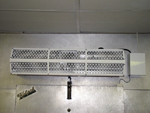
The walk-in cooler entrance is shown with Berner’s Walk-in Cooler Efficiency Kit installed. (Click on the image for an enlarged view.)
Donoghue & Pivirotto Enterprises Inc., Wexford, Pa., which operates four Arby’s stores, performed a two-week audited test on a 10- x 12-foot walk-in cooler at its 3,300-square-foot Arby’s in Butler, Pa. After outfitting the walk-in cooler entrance with an air curtain, the results indicate the refrigeration circuit’s compressor ran 1.75-hours less during one week - a 27 percent reduction in compressor run-time and equipment wear-and-tear. The improvement results in nearly 100 fewer operating hours per year for an estimated annual savings of $447 and a 1.6-year payback on a walk-in cooler entrance air curtain.
Aside from operational savings, the test results are noteworthy for restaurateurs, foodservice operations, and food retailers faced with the new Energy Policy and Conservation Act (EPCA) (Section 312) compliance. The code mandates air infiltration reduction methods, such as strip curtains, spring-hinged swinging vinyl doors, or other options, for all walk-in coolers manufactured after Jan. 1, 2009, but doesn’t specify which is the most efficient. Now, the Arby’s test affirms the assumed energy efficiency of air curtains.
“We’re one of Arby’s higher volume stores, and we’ve now proven that installing an air curtain on a walk-in cooler reduces energy and wear-and-tear,” said Doug Cygan, vice president of operations, Donoghue & Pivirotto Enterprises. “Larger, higher volume restaurants, especially those with the newer design trend of freezer-cooler combinations that result in double the weekly door cycles, would no doubt save more than 27 percent using this technology approach,” said Cygan, a 10-year refrigeration industry veteran who has an HVACR vocational technology degree and also operates a mechanical contracting company, ICA Mechanical LLC, Butler, Pa.
The threshold of door cycles per week should average 300 or more for a cost-effective payback, according to Phil Thomas, project engineer, Berner International, New Castle, Pa.

The Walk-in Cooler Efficiency Kit is a combination of a control package and a K-Zone air curtain. (Click on the image for an enlarged view.)
The test compared one week of unaltered operational statistics of a 26-year-old, 2-ton walk-in cooler manufactured by Kolpak, Manitowoc, Wis., to another week’s results after installing a K-Zone air curtain by Berner International. The test recorded five variables: temperatures in the back interior and at the door entrance of the walk-in cooler, kitchen temperature, and amp draw of both the compressor and the air curtain.
The test was performed with a Simple Logger II-Model L102, AEMC Instruments, Foxborough, Mass., to capture power consumption in amps every five seconds. More than 120,000 data points for electric current were graphed weekly. Temperatures were recorded with a Measurement Computing USB-501 data logger by National Instruments, Austin, Texas. More than 16,000 data points were captured at each of the five locations weekly. The temperature and amp-draw figures were combined and graphed in Microsoft Excel for review. (The two graphs provided in the PDF links below illustrate the test results with no air curtain and with an air curtain installed.)
While many foodservice industry members are not yet aware of the EPCA code, those who try to comply confront both cost and installation obstacles when implementing a door with an air curtain, activation switch, and electrical power supply wiring. Consequently, after the EPCA code enactment, Berner International developed its Walk-In Cooler Efficiency Kit in 2010, an air curtain and control package combination that streamlines the compliance procedure and can be easily installed by contractors or in-house maintenance employees.
Thomas estimates a restaurant chain can save thousands of dollars by potentially avoiding a compressor, evaporator, or condenser coil replacement, induced by wear-and-tear.
Now that air curtains have demonstrated that they improve walk-in cooler efficiencies, Cygan plans a Walk-In Cooler Efficiency Kit to be installed at another Donoghue & Pivirotto high-volume store. Cygan also expects word about walk-in cooler air curtains to spread throughout the chain when Arby’s corporate franchise business manager makes an expected stop in Butler this year.
For more information, visit www.berner.com.
Publication date:05/23/2011

Report Abusive Comment